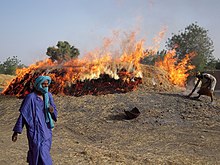

Pit firing is the oldest known method for the firing of pottery. Examples have been dated as early as 29,000–25,000 BCE,[1][2] while the earliest known kiln dates to around 6000 BCE, and was found at the Yarim Tepe site in modern Iraq.[3] Kilns allow higher temperatures to be reached, use fuel more efficiently, and have long replaced pit firing as the most widespread method of firing pottery, although the technique still finds limited use amongst certain studio potters and in Africa.
Unfired pots are nestled together in a pit in the ground and are surrounded by combustible materials such as wood, shavings, dried manure, leaves, and sometimes metal oxides and salts to affect the surface of the pots. The top of the pit may be protected with moist clay, shards, larger pieces of wood, or metal baffles. The filled pit is then set on fire and carefully tended until most of the inner fuel has been consumed. At around 1,100 °C (2,010 °F) the maximum temperatures are moderate compared to other techniques used for pottery,[4] and the pottery produced counts as earthenware. After cooling, pots are removed and cleaned; there may be patterns and colours left by ash and salt deposits. Pots may then be waxed and buffed to create a smooth glossy finish.[5]
- ^ "Modern Ceramic Engineering: Properties, Processing And Use In Design." D.W. Richerson. CRC Press. 2006.
- ^ "On the Origins of Pottery." P.M.Rice. Journal of Archaeological Method and Theory. Vol 6, No.1. 1999.
- ^ Piotr Bienkowski; Alan Millard (15 April 2010). Dictionary of the Ancient Near East. University of Pennsylvania Press. p. 233. ISBN 978-0-8122-2115-2.
- ^ "Ceramics: A Potter's Handbook." G.Nelson. Holt, Rinehart & Winston. 1984.
- ^ "Mastering Raku." S.Branfman. Sterling Publishing Company. 2009.
